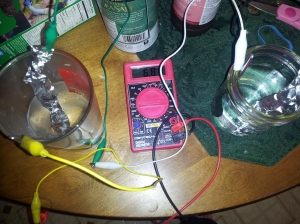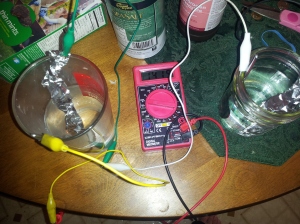sink battery
So, part of the problem with my previous batteries was the low amperage. I can add on cells to increase voltage no matter the size, but the amperage is only going to increase with a decrease in internal resistance, either in the electrolyte or the surface area of the electrodes.
Everybody has stainless or iron pans, aluminum foil and salt. I put a few inches of salt water in the bottom of my stainless kitchen sink, and floated a sheet of aluminum foil just below the surface. This produced about 200 mV, I added a packet of Emergen-C and that bumped it up to 300 mV and 10 mA sustained. When I added hot water and lightly agitated and was able to get it up to 600 mV but it always settled down around 400 mV.
But to get 12 volts would take 40 cells, kinda unfeasible to string 40 pans around the kitchen in an emergency. 17 pans for 5+ volts to charge a cellphone… still unfeasible. 5 pan cells would be 1.5 volts… enough to charge a AA battery, but only 50 mA, slow charge of only one battery.
I think next I’ll try aluminum and carbon.

